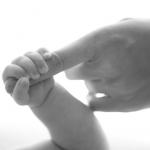![baby-wearing[1]](https://wp-media.patheos.com/blogs/sites/335/2013/06/baby-wearing1-150x150.jpg) Every parent has had the experience of having to walk around carrying a crying baby to soothe him. We have a lot of different ways to soothe a crying baby, but when all else fails, carrying often does the trick. Why does carrying succeed when other strategies–including merely holding the baby–fail?
Every parent has had the experience of having to walk around carrying a crying baby to soothe him. We have a lot of different ways to soothe a crying baby, but when all else fails, carrying often does the trick. Why does carrying succeed when other strategies–including merely holding the baby–fail?
Studying the process of infant soothing is extremely important because inconsolable babies are more susceptible to abusive treatment by parents. Understanding the psychological or biological mechanisms that enables infants to be calmed is a significant public health concern. Because of this, researchers at the RIKEN Brain Science Institute decided to investigate whether there was a neurological basis for the effectiveness of infant carrying. They discovered some surprising things.
Carrying Triggers Newly Discovered Calming Reflex
It turns out that carrying an infant triggers a three-way mechanism in the brain that suppresses involuntary muscle movements & struggling while also dramatically reducing the infant’s heart rate. These changes happen almost immediately. In fact, this process is such an automatic response to being carried that it could almost be considered a previously undiscovered reflex. The study noted that merely holding a baby does not stimulate this reflex. Only carrying does.
Moreover, this relaxing response to being carried by one’s parent is not just found in humans, it is consistent across mammals–from mouse pups to lion cubs–indicating that this response is a deeply ingrained part of mammalian brain programming. Indeed, the study notes that the brain mechanisms responsible for this soothing reaction is controlled by the cerebellum (which is responsible for monitoring muscle control) and the parasympathetic nervous system (responsible for relaxing the body).
So What? –The Practical & Spiritual Significance of Infant Carrying
Practically speaking, research like this gives further weight to the recommendation to practice “baby wearing“; that is, keeping a baby close to your body in a sling to maximize bodily contact between parent and infant. Pope John Paul II’s Theology of the Body suggests that as we prayerfully contemplate the meaning of the body, we can discover God’s intention for how we are to relate to one another. In light of his profound reflection, findings like this from the RIKEN Brain Science Institute are even more significant. Think about it. God actually created structures in the brain that require a specific kind of external stimulation in order to be activated! Even the our brains are not entirely our own. The brain is truly a social organ that effectively reaches outside of us so that it find wholeness and health by plugging into the surrounding social network. Understanding this offers stunning new insights into why Genesis 2:18. Findings like this speak to both the deeply social nature of the human person and gives neurobiological credence to the otherwise merely philosophical assertion that we were created, primarily, to love and be loved.
When parents are willing to learn from the instruction manual God has given them in the form of their baby’s cues, both parents and baby can be happier and healthier.
For more information on how principles from interpersonal neurobiology and the theology of the body can make your parenting life easier and more effective, check out Parenting with Grace: A Catholic Parent Guide to Raising (almost) Perfect Kids.















